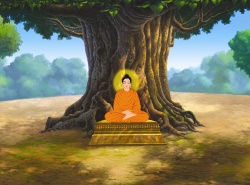Nibbāna
- See also Nirvana
(Sanskrit nirvāna): lit. 'extinction' (nir + Ö va, to cease blowing, to become extinguished); according to the commentaries, 'freedom from desire' (nir+ vana). Nibbāna constitutes the highest and ultimate goal of all Buddhist aspirations, i.e. absolute extinction of that life-affirming will manifested as greed, hate and delusion, and convulsively clinging to existence; and therewith also the ultimate and absolute deliverance from all future rebirth, old age, disease and death, from all suffering and misery. Cf. Parinibbāna.
"Extinction of greed, extinction of hate, extinction of delusion: this is called Nibbāna" (S. XXXVIII. 1).
The 2 aspects of Nibbāna are:
- (1) The full extinction of defilements (kilesa-parinibbāna), also called sa-upādi-sesa-nibbāna (s. It. 41), i.e. 'Nibbāna with the groups of existence still remaining' (s. upādi). This takes place at the attainment of Arahatship, or perfect holiness (s. ariya-puggala).
- (2) The full extinction of the groups of existence (khandha-parinibbāna), also called an-upādi-sesa-nibbāna (s. It. 41, A.IV.118), i.e. 'Nibbāna without the groups remaining', in other words, the coming to rest, or rather the 'no-more-continuing' of this physico-mental process of existence. This takes place at the death of the Arahat. - (App.: Nibbāna).
Sometimes both aspects take place at one and the same moment, i.e. at the death of the Arahat; s. sama-sīsī.
"This, o monks, truly is the peace, this is the highest, namely the end of all formations, the forsaking of every substratum of rebirth, the fading away of craving, detachment, extinction, Nibbāna" (A. III, 32).
"Enraptured with lust (rāga), enraged with anger (dosa), blinded by delusion (moha), overwhelmed, with mind ensnared, man aims at his own ruin, at the ruin of others, at the ruin of both, and he experiences mental pain and grief. But if lust, anger and delusion are given up, man aims neither at his own ruin, nor at the ruin of others, nor at the ruin of both, and he experiences no mental pain and grief. Thus is Nibbāna visible in this life, immediate, inviting, attractive, and comprehensible to the wise" (A.III.55).
"Just as a rock of one solid mass remains unshaken by the wind, even so neither visible forms, nor sounds, nor odours, nor tastes, nor bodily impressions, neither the desired nor the undesired, can cause such a one to waver. Steadfast is his mind, gained is deliverance" (A.VI.55).
"Verily, there is an Unborn, Unoriginated, Uncreated, Unformed. If there were not this Unborn, Unoriginated, Uncreated, Unformed, escape from the world of the born, the originated, the created, the formed, would not be possible" (Ud.VIII.3).
One cannot too often and too emphatically stress the fact that not only for the actual realization of the goal of Nibbāna, but also for a theoretical understanding of it, it is an indispensable preliminary condition to grasp fully the truth of anattā (q.v.), the egolessness and insubstantiality of all forms of existence. Without such an understanding, one will necessarily misconceive Nibbāna - according to one's either materialistic or metaphysical leanings - either as annihilation of an ego, or as an eternal state of existence into which an ego or self enters or with which it merges. Hence it is said:
"Mere suffering exists, no sufferer is found;
The deed is, but no doer of the deed is there;
Nibbāna is, but not the man that enters it;
The path is, but no traveler on it is seen."
(Vis.M. XVI)
Literature
- For texts on Nibbāna, see Path, 36ff. -
- See Vis.M. XVI. 64ff. -
- Anattā and Nibbāna, by Nyanaponika Thera (WHEEL 11);
- The Buddhist Doctrine of Nibbāna, by Ven. P. Vajiranana & F. Story (WHEEL 165/166).
